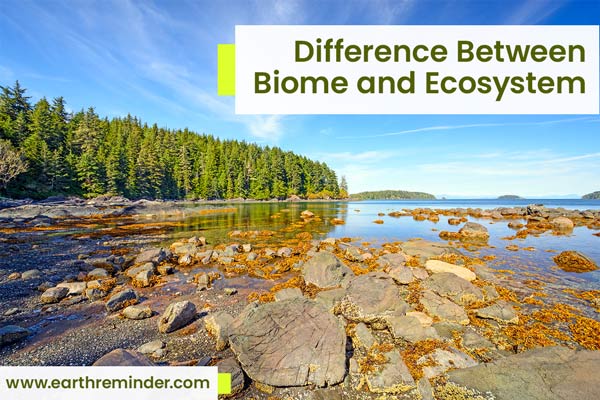Difference Between Biome and Ecosystem
Biome Vs. Ecosystem: On the surface, biomes and ecosystems may seem not so different; however, they represent totally different realities. All biomes include several ecosystems. However, the ecosystem only represents physical and chemical interactions between living and not loving things in a small area.
Therefore, the difference between a biome and an ecosystem comes from what they describe and how the concepts are applied to understand and classify flora and fauna populations across various geographies.
If we look upon the definition, a biome is a large area comprising distinct plants and animals. The plant and animal population one finds in a given biome is well adapted to the climatic conditions of that biome. In contrast, the ecosystem is a smaller space where living things interact with each other and with nonliving components to sustain life in that place.
Table of Contents
What Is an Ecosystem?
The fundamental unit of any environment is known as the ecosystem. It comprises a set of animals, plants, and micro-organisms, all in constant interaction with each other and with their environment. An ecosystem can be as small as a pond and comprise its own sets of living and non-living thing components. Incidentally, a forest, a cliff, and a beach represent an ecosystem.
Besides that, there are two essential components that every ecosystem on the planet includes: the biotope and the biocenosis.
Biotope represents the non-living components of an ecosystem. The soil, water, air, and all the physio-chemical processes going on in an ecosystem comes under the term biotop.
Biocenosis encompasses all the living things in an ecosystem. Plants, animals, insects, bacteria, fungus, and other microorganisms all come under the term biocenosis.
Types of ecosystems: Terrestrial Ecosystem, Aquatic Ecosystem, Marine Ecosystem, Arctic Ecosystem, etc.
Examples of ecosystems: Ponds, Mountain cliffs, forests, etc.
What is a Biome?
Unlike the ecosystem, a biome generally refers to a large geographical area representing particular sets of plants and animals. Moreover, each biome is characterized by a unique climate, and, consequently, plants and animals that have adapted well to that climate and environment.
One more fact about biomes is that biomes are often characterized by the types of vegetation prevalent in that geographic area. Thus, tropical forests, Mediterranean forests, etc., represent a distinct biome.
Additionally, biomes can also be considered an extensive collection of smaller ecosystems over a vast territory. In this sense, a biome encompasses several small-scale ecosystems.
Types of Biomes: Grassland biome, Aquatic biome, Forest biome, Tundra biome, and Desert biome.
Examples of Biomes: Tropical rain forests, temperate forests, Savannah, etc.
What Is the Difference Between a Biome and An Ecosystem?
The concepts of biome and ecosystem are devised to understand and categorize how plants and animals adapt and evolve given particular circumstances like geography, climate, and environment. But individually, biomes and ecosystems are not the same things.
The main difference between biome and ecosystem is that biome comprises a collection of ecosystems in a given geographical area with distinctive climate, vegetation, and animal population. In comparison, an ecosystem represents the interaction between living and non-living components at a much smaller level, like a pond.
Furthermore, a biome is characterized by the climate and the vegetation that evolved in response to those climatic conditions. Similarly, a biome extends a vast geographic area, while an ecosystem could be limited to a very small space. Also, a biome only represents the set climate, flora, and fauna of a given latitude. In contrast, an ecosystem represents the interactions that are going on between the species residing in that area and what level they occupy in the food chain.
Biome vs Ecosystem: Comparison Table
| Biome | Ecosystem | |
| Definition | Biome is a large area with distinct climate and vegetation. | An ecosystem is a small area encompassing all the interactions happening between its living and nonliving components. |
| Geographic Limits | Biomes differ with geographies like the tundra biome, which is very different from a tropical forest biome. | The ecosystem is not influenced by the location. |
| Climate dependencies | A biome is shaped by the type of climate in a given area. | The ecosystem is not influenced by weather because the interactions continue irrelevant of the climatic conditions. |
| Components | A biome can include several ecosystems. | An ecosystem includes biotic and abiotic components. |
| Interactions | It is possible that the species that make up a biome do not interact with one another. | In an ecosystem, living things continuously interact with each other and with the abiotic component, like air, water, and soil. |
| Examples | Tropical rainforests, Tundra etc. | Ponds, mountain cliffs, etc. |
Biome Vs. Ecosystem: Conclusion
Biome and ecosystem are two different terms. In a broad sense, both may refer to how life in general evolves and thrives in a given environment. But at the root, the biome and ecosystem diverge from each other. While the biome encompasses both flora and fauna of a given area, the ecosystem merely represents how living things and non-living things enable life in a given area through constant interactions.
The definition of both terms also gives a glimpse of another difference between biome and ecosystem: the biome spans a wide area, while the ecosystem is limited to a small region. Although biomes and ecosystems are two different entities, they represent a common factor – life. By learning their differences, we also improve our understanding of how life evolves and thrives on our planet and what factors shape the forms, habits, characteristics, and traits of living things in a given area.
